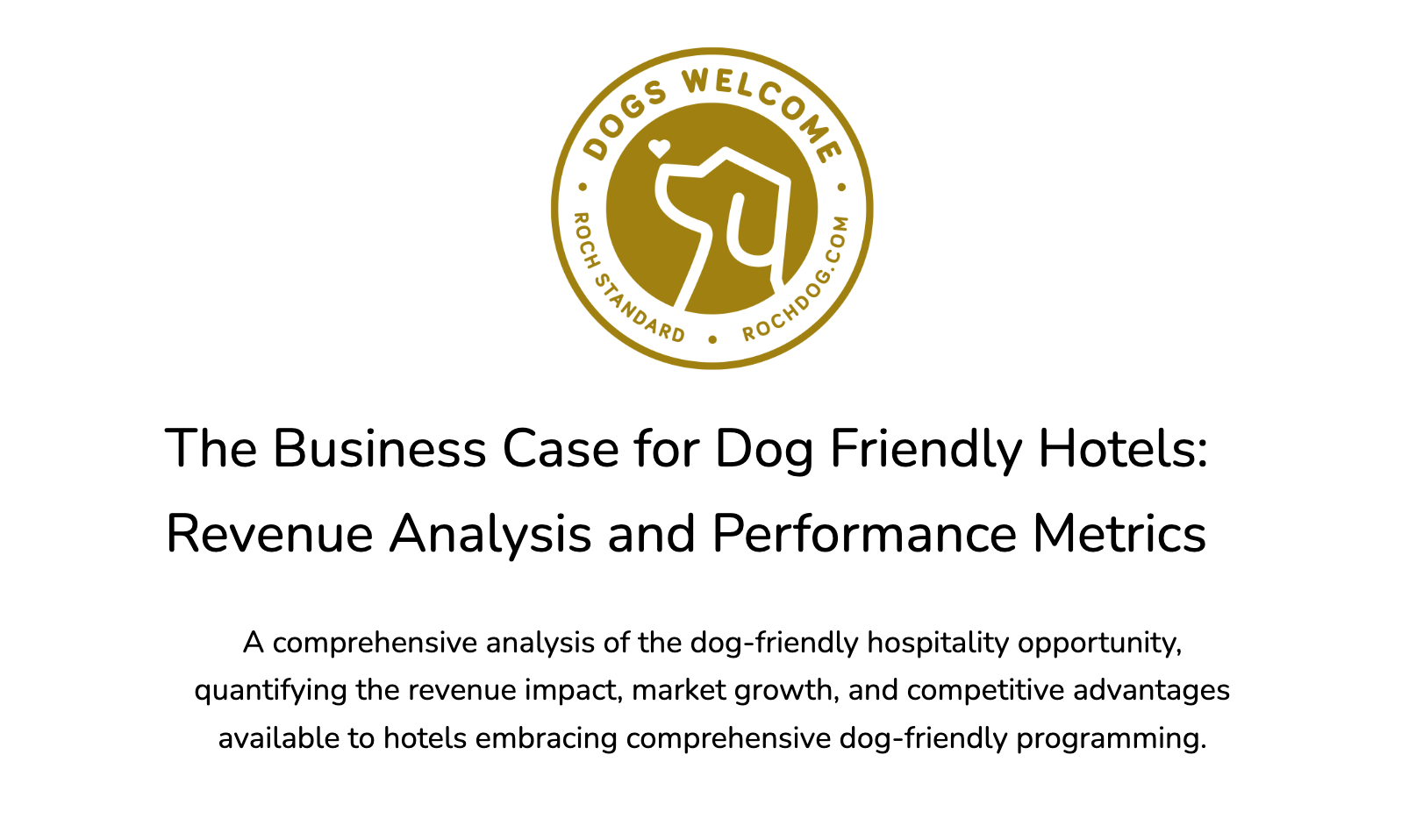The Business Case for Dog-Friendly Hospitality: Generate 28% More Annual Revenue
Dog-friendly hotels generate $750K-$4M more revenue annually through 20% higher occupancy, 30% increased spending, and exceptional guest loyalty.

Here’s a number that should get every hotel revenue manager’s attention: comprehensive dog-friendly programming generates between $750,000 and $4 million in incremental annual revenue per property. Not projected revenue. Not theoretical upside. Actual, measurable revenue increases documented in new research analyzing the financial impact of pet hospitality across the hotel industry.
Yet many operators still treat pet policies as an afterthought, a reluctant concession to demanding guests rather than a strategic revenue initiative.
That perspective is costing hotels serious money while competitors capture a demographic segment that spends more, stays longer, and returns more often than virtually any other guest category. Our new research report “The Business Case for Dog-Friendly Hotels: Revenue Analysis and Performance Metrics” provides the data-driven evidence operators need to justify this strategic shift.
Why This Matters Right Now
The dog-friendly hotel market is expanding from $4.6 billion in 2025 to $7.29 billion by 2029, a compound annual growth rate of 12.2% that significantly outpaces the broader hospitality sector. This isn’t incremental growth. It’s a fundamental shift in travel behavior that’s creating a competitive window for properties willing to act decisively. The data behind this shift is striking. Seventy percent of U.S. households now own pets, and 78% of dog owners travel with their animals annually. These aren’t occasional leisure travelers, they’re making frequent booking decisions based explicitly on pet accommodation policies.
Hotels maintaining restrictive policies aren’t protecting their brand; they’re turning away high-value customers who will gladly book with competitors.
The DINKWAD Demographic Nobody’s Talking About
There’s a demographic revolution happening that most hospitality strategists are missing. Meet the DINKWADs: double income, no kids, with a dog. This affluent cohort treats their dogs as family members and controls $259 billion in annual spending power, projected to reach $427 billion by 2030.
These aren’t people looking for tolerance of their pets. They’re demanding genuine hospitality that treats their dogs as valued guests—and they’re willing to pay premium rates for properties that deliver. Younger travelers especially are driving this trend, with many refusing to travel without their dogs altogether. This is what researchers call the “pet humanization trend,” and it’s reshaping consumer behavior across multiple industries, not just hospitality.
The Three Revenue Drivers That Actually Matter
Academic research published in the International Journal of Contemporary Hospitality Management, the same journal that validated revenue management systems and dynamic pricing, has now definitively quantified how dog-friendly policies impact the bottom line. The findings reveal three compounding advantages that make this one of the highest-return strategic initiatives available to hotel operators today. Lets take a closer look at these drivers.
Driver 1: The Occupancy Advantage - Dog-friendly hotels achieve 15-20% higher occupancy rates compared to non-dog-friendly properties. Stop and consider what that means operationally. Most revenue managers struggle to move occupancy by even single percentage points. A 15-20% advantage represents a fundamental competitive edge that persists year-round.
The mechanism works through multiple channels. Dog owners travel more consistently throughout the year, filling shoulder season rooms that would otherwise sit empty. They show less price sensitivity when dog-friendly options are scarce, allowing properties to maintain stronger rates during traditionally slow periods. And they book extended stays that reduce turnover costs while maximizing revenue per available room.
Let’s make this concrete with real numbers. Consider a 250-room property operating at 70% occupancy with a $350 average daily rate. Even a conservative 5% occupancy lift adds 4,563 room nights annually, generating $1.6 million in incremental room revenue before accounting for any additional spending. Scale that to a 400-room property at $450 ADR, and the same 5% lift produces $2.5 million in additional revenue from occupancy alone. Unlike promotional discounts that erode margins, this occupancy advantage compounds year after year, creating predictable recurring revenue that supports better financial planning.
Driver #2: The Spending Premium - Dog owners don’t just fill rooms—they spend 30% more than other guests on on-property amenities including food and beverage, spa services, and retail offerings. This isn’t about affluence; it’s about behavior patterns that create a captive, high-spending audience for amenities.
The logic is straightforward.
Dog owners are reluctant to leave animals unattended in guestrooms, making them far more likely to utilize hotel restaurants, bars, and recreational facilities rather than venturing off-property. While standard guests explore local restaurants or attractions, dog-owning guests default to on-property options that accommodate their dogs, driving F&B covers and ancillary service revenue. The aggregate impact is substantial: pet-friendly properties generate 28% more bookings and 30% more revenue on average than comparable non-pet-friendly properties. For revenue managers, this represents a rare opportunity to drive both occupancy and RevPAR simultaneously, a combination that’s nearly impossible to achieve through traditional demand generation strategies.
Driver #3: The Length-of-Stay Multiplier - Guests traveling with dogs stay an average of 2.56 nights compared to 2.1 nights for guests without dogs—a 22% longer duration that creates compounding revenue opportunities. The mathematics are powerful: an additional 0.46 nights per booking multiplied across 1,000 dog-owning bookings annually equals 460 additional occupied room nights. At a $350 ADR, that’s $161,000 in incremental room revenue purely from extended stay duration, with zero additional marketing cost or occupancy displacement.
Longer stays also generate operational efficiencies. They reduce housekeeping intensity, minimize check-in/check-out processing, and create additional touchpoints for upselling premium services. Each additional night represents another opportunity for room service orders, restaurant visits, spa bookings, and retail purchases—compounding that 30% spending premium across multiple days.
The Loyalty Factor Nobody Expected
After a successful stay, 76% of dog owners become loyal repeat guests. Compare that to typical hospitality loyalty benchmarks, which hover between 30-40% for most segments. This represents a fundamental advantage in customer lifetime value that compounds over multiple years. The loyalty stems from practical friction. Dog owners face significant challenges finding suitable accommodations, as many properties either don’t accept pets or impose restrictive policies.
When they discover a property that genuinely welcomes their animals with thoughtful amenities and trained staff, they face strong incentives to return rather than risk disappointing experiences elsewhere. This “loyalty through relief” transcends traditional reward programs. Consider the economics: a guest who visits once generates single-visit revenue, but a guest who visits annually for a decade generates 10x the amount with minimal incremental acquisition cost.
A couple spending $1,500 per visit represents $15,000 over ten years. If they refer three additional pet-owning households who become similarly loyal, the total customer LTV exceeds $60,000, all from one initial positive experience.
The Premium Service Layer
Beyond base occupancy gains, services create entirely new revenue streams. Pet fees alone, ranging from $25 to $250 per stay depending on brand positioning, provide direct incremental revenue with minimal associated costs. The real opportunity extends far beyond basic fees. Hotels offering services like grooming, dog-sitting, dog-walking, and premium pet packages can achieve 10-15% profit margin improvements. At successfully managed dog-friendly hotels, pet-related services contribute 5-8% of total revenue and 25-30% of overall profit.
Leading properties are pioneering sophisticated offerings that create memorable experiences while driving margins. The Kona Kai Resort in San Diego offers “pawroma therapy” and dog massages. The Rosewood Las Ventanas in Los Cabos provides “doga”, yoga sessions designed for dogs and owners. The W Punta de Mita in Mexico offers dog surfing lessons. These aren’t gimmicks; they’re high-margin service offerings that generate social media content and differentiate properties in crowded markets. Even properties without extensive budgets can create meaningful value. Basic amenities like quality food and water bowls, comfortable dog beds, welcome treats at check-in, and dedicated relief areas cost relatively little but significantly enhance perceived value for dog-owning guests.
The Competitive Clock Is Ticking
The dog-friendly opportunity isn’t infinite. Research shows that 46% of hotels in major urban markets now welcome canine guests, up from minimal percentages a decade ago. In high-demand leisure markets, that percentage exceeds 60%.
As more properties embrace comprehensive pet programming, early-mover advantages diminish. Hotels establishing strong reputations for canine hospitality now will capture loyalty that becomes difficult for competitors to break later.
Properties that delay implementation face a dual challenge: they lose market share to established competitors while simultaneously entering an increasingly crowded field where differentiation requires greater investment.
The implementation pathway varies by property type and brand positioning. Budget and mid-scale properties can achieve significant results with relatively modest investments: designated relief areas, basic in-room amenities, clear pet policies, and staff training. Luxury and upper-upscale properties require more sophisticated offerings, pet menus, spa services, play areas, and concierge services, to meet elevated guest expectations. Hotels that already accommodate dogs but do so minimally represent the greatest untapped opportunity. Moving from tolerance to genuine canine hospitality requires relatively modest incremental investment but generates substantial revenue dividends.
From Speculation to Strategic Imperative
The dog-friendly hospitality opportunity has matured from speculative trend to financially validated strategic imperative. Dog-friendly programming delivers 15-20% occupancy gains, 30% spending premiums, 22% longer stays, and 76% loyalty conversion rates, metrics that few other strategic initiatives can match.
A mid-sized property can generate $750,000 to $4 million in incremental annual revenue through comprehensive dog-friendly programming. These are conservative estimates based on actual performance data, requiring modest investment relative to alternative revenue initiatives that deliver far less certain outcomes. The strategic question isn’t whether dog-friendly programming generates returns, the research definitively answers that. The real question is whether hotels will act decisively while competitive advantages remain available, or adopt reactively after competitors have captured market position.

The Business Case for Dog-Friendly Hotels: Revenue Analysis and Performance Metrics
Research report quantifying how dog-friendly hospitality drives $750K-$4M in incremental revenue per property through 15-20% higher occupancy, and 30% increased discretionary spending.
I hope our research is of value to you, if you wish to discuss any aspect please schedule in a conversation with the analyst by clicking here, so you can let me know your thoughts, and I can answer any questions you might have.


